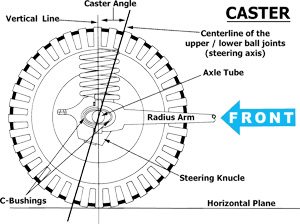What are Caster, Camber, and Toe?
Learn how caster, camber, and toe affect your ability to drive and control your Jeep. Having the proper caster, camber and toe helps you to avoid excess wear and tear on your tires, get the best stability while driving, and an overall better driving experience, especially when turning. Driving with improper caster, camber, or toe may result in tires balding too quickly, danger while turning, and poor stability. Refer to the images below for easy reference.
What is Caster?
Caster is the fore or aft slope of the steering axis. The steering axis is a line drawn through the upper and lower ball joints of the knuckle. Positive caster is when the bottom of the steering axis line is in front of the tire's contact patch. Zero caster is when the steering axis is at 0 degrees. Factory alignment specs for basically all vehicles call for a certain degree of positive (shown) caster. This ensures good stability, helps maintain straight-ahead direction and promotes steering wheel self-centering.
What is Camber?
Camber is the inward or outward tilt of the front tires as viewed from the front. Inward tilt is negative, outward tilt is positive. Camber is used to distribute load across the entire tread. Improper camber makes the tire wear on one edge, and causes the vehicle to pull to the side that has the most positive camber.

What is Toe?
Toe is the side-to-side difference in distance between the front and rear of the front tires. If the distance is closer at the front, it's called toe-in. If the difference is closer at the rear, it's called toe-out. Toe affects directional stability and turning.

Courtesy of Superlift Supspension





